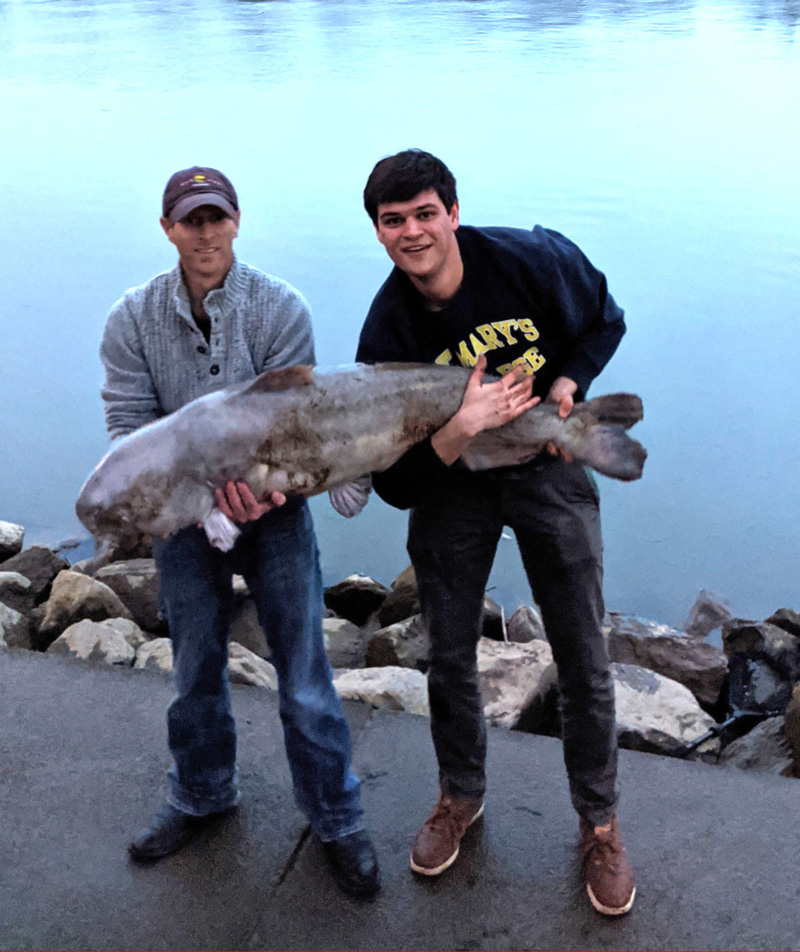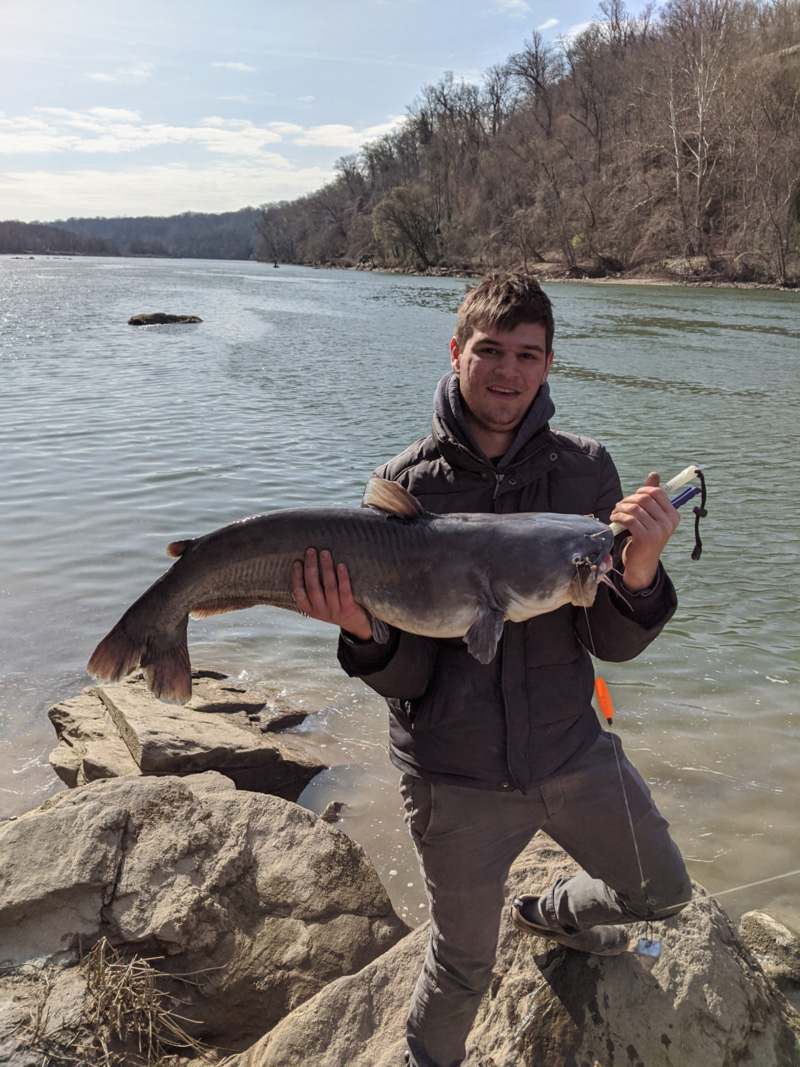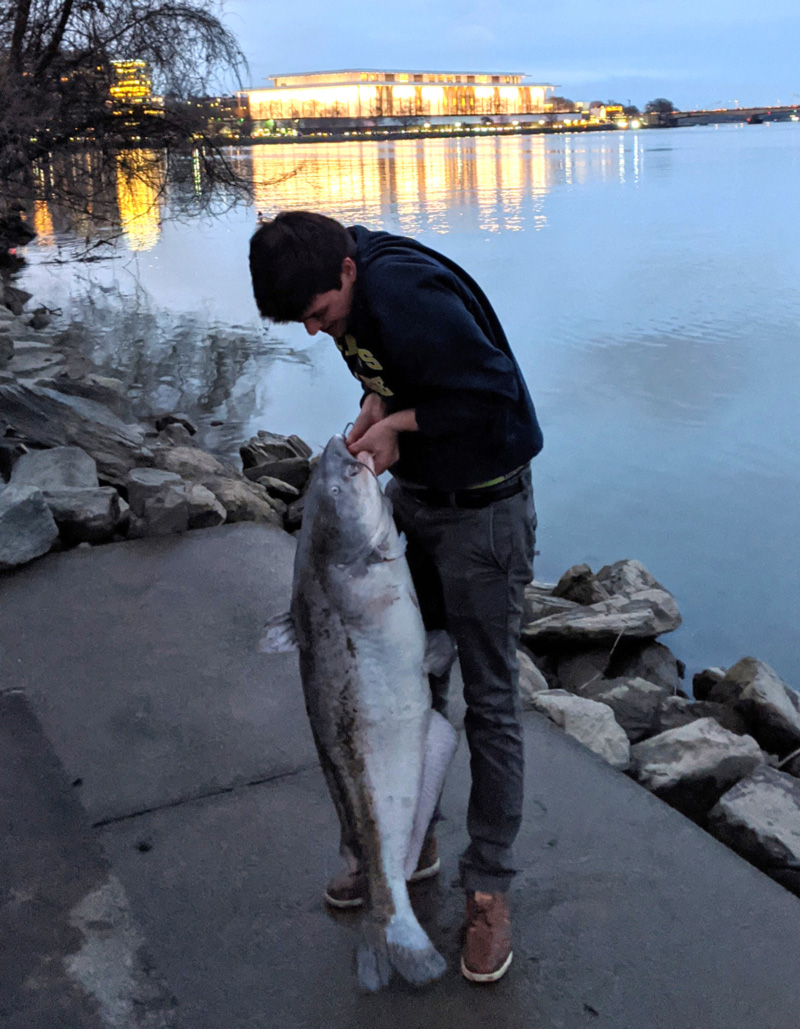Winter is trophy season for blue catfish, and fish over 40-inches can easily be targeted from the shore as well as from boats. While most of my personal experience is on the Potomac River, the techniques discussed here are applicable anywhere and can be fine-tuned to your closest waters. After getting the breakdown on the gear, baits, and locations necessary to get you on a big old blue, you’ll be ready to keep your fishing season rolling all year round.

Blue Catfish Fishing Gear
Big blue catfish love water with deep pockets and a strong current. Therefore, your gear needs to be up for the challenge. If you’re fishing from the bank, surf rods 10 feet or longer are necessary to cast long distances and provide the most effective backbone. Rods with a soft tip, heavy power, and moderate-to-fast action are best for ‘loading’ up the rod and delivering the pressure when you get a bite. You can size down the length if you’re fishing from a boat, but will still want a rod with medium-heavy power and moderate action to handle large fish.
Spinning and conventional reels both work great, but if you’re fishing rom shore high line capacity is crucial to cast far and reach the bottom in 50 to 80 feet of water. The great part about this kind of fishing is that your reel can be as bulky as you want because you aren’t casting or retrieving with much frequency. Reels with a baitrunner feature or clicker are helpful when working without proper rod holders, or when the fish are being picky. Letting them run for five seconds before turning on your drag can help hook even the pickiest fish. If I do have access to quality rod holders, I like to leave my drag cranked down to get a firm hookset right when the fish takes off.
Terminal tackle is an important consideration because it can be the deciding factor between landing or losing the one bite that counts. With nearly all my catfishing, I use a simple fish-finder rig. Chances are, you’re typically already using similar gear to fish live bait or drift chunks. It consists of a sliding clip on the mainline (40-pound test braid is a good choice) followed by a bead, and tied off with a Palomar knot to a barrel swivel. From there, attach a leader of one to two feet of 50-pound test monofilament, and snell a 10/0 circle hook to the end. If I have the time and means, I will put a float two inches from the hook to lift the bait slightly off the bottom.

Big catfish love structure as much as any other fish. So, if you’re fishing near structure and getting cut off, switch to a rig with a monofilament mainline for extra abrasion resistance.
Best Baits for Trophy Blue Catfish
Most people think of catfish as scavengers, but the diet of a trophy blue largely consists of baitfish, clams, eel, and other live baits. One can catch catfish using “grocery store” baits like hotdogs and chicken livers, but a large catfish’s diet is nearly all live fish and can be specifically targeted by using live or fresh cut bait. Tackle shops, fish markets, and grocery stores are all great places to get fresh fish to use for cut bait if you can’t catch your own. Fresh is always better than frozen, but I have had tremendous success using frozen white perch over the winter, so it’s good to know they aren’t too picky. Shad, mullet, and strips of carp are also great baits with the potential to catch a trophy.
Catfish Hotspots
Choosing the right location to cast your baits can be tough, but there are a few rules to follow to help avoid a skunk. First and foremost, deep water is key. After you cast, you should be free-spooling line for at least 10 seconds before your bait hits the bottom. Current and lead weight can change this time, but the best spots will pull line for 30 seconds or more after you cast. There are many spots around the Upper Potomac that reach 80 feet or more and during the winter, blues like to school up in these pockets. If you aren’t getting a bite in 15 minutes, recast. After 30 to 60 minutes with no bites, change spots.
If you’ve found deep water but aren’t getting bit, look for a foam line towards the middle of the river. While this is not always the case, the foam on the surface can sometimes point to the fastest current which is generally in the channel. I have had success aiming my casts into these zones, especially when I wasn’t getting bites closer in. This is when surf rods (or fishing from a vessel) come into play because they allow you to access areas that may be tough to reach from shore.

On the Potomac, places like Fort Washington, the D.C. Tidal Basin, Georgetown Waterfront Park, Fletcher’s Boathouse, and Chain Bridge all hold trophy size catfish, especially through the winter. While it may surprise some, the upper Potomac is tidal and blue catfish do react strongly to its ebb and flow. The fact remains that you can cast the most appetizing bait in the world into a honey hole and still get skunked. More often than not, this is because the tides weren’t in your favor. Although patterns will change, from my experience, an outgoing tide is typically best, especially as it slows into a slack low tide. Oftentimes the break in current from a slack tide allows blues to spread out more, and they tend to feed heavily during these windows. Pair these conditions with a dawn or dusk bite, and you’ll be in big fish territory.
Whether you’re a novice fisherman looking to add another fish to your list or a trophy hunter looking for something to fill your off-season, you’ll be well on your way to catching monster blue catfish, all within minutes of the nation’s capital. Even if you aren’t local, bring your family and go fishing while they’re on vacation — better yet, bring them along and snag the fish of a lifetime.
-By Aaron Weinstein